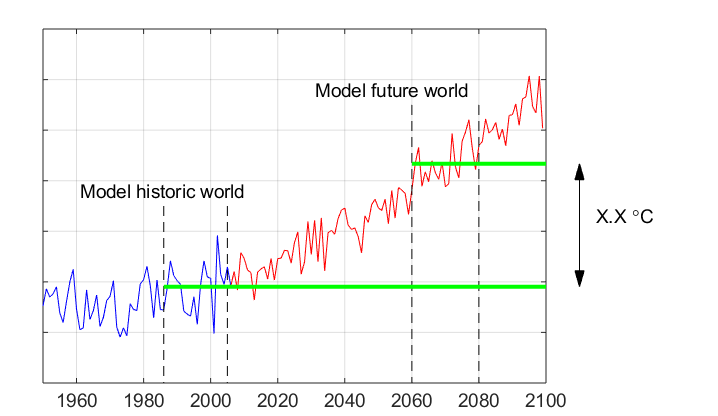Climate Change in Australia
Climate information, projections, tools and data
Download Datasets
This page provides download links for a range of data produced for the 'NRM' Projections that were released in 2015 and were produced from the Coupled Model Intercomparison Project phase 5 (CMIP5) generation of Global Climate Models (GCMs). For a summary of the NRM datasets available, please download the CCiA NRM Data Delivery brochure (6.1 MB PDF).
The page also provides links to more recent data produced by the Australian Climate Service from the current, Coupled Model Intercomparison Project phase 6 (CMIP6), generation of GCMs and to relevant historical datasets.
All available datasets are subject to Terms of Use, which include conditions related to acknowledgements, redistribution and commercial use.
The following Australian Climate Service datasets are available under a CC BY 4.0 licence:
The following datasets are available under a non-commercial use:
- NRM CMIP5 Future Climatological Averages (stations)
- NRM CMIP5 Fire Danger Index Summaries (stations)
- NRM CMIP5 Future Gridded Change Data (native grid)
- NRM CMIP5 Application-Ready Gridded (5 km) Datasets
- NRM CMIP5 Thresholds Datasets (5 km Gridded)
- NRM CMIP5 Application-ready Station Datasets
The following datasets are available on request, with a variety of different terms of use:
CMIP6 APPLICATION-READY GRIDDED DATASETS
Australian Climate Service application-ready datasets are available for nine CMIP6 GCMs selected for dynamical downscaling over Australia by the Australian Climate Service and the NSW Government’s NARCliM2.0 project (see here for more information). A Technical Report describes these datasets in detail. Daily data for a 30-year mid-century period centred on 2050 (2035-2064) and a late-century period centred on 2085 (2070-2099) are available for four greenhouse gas emissions pathways (SSP1-2.6, SSP2-4.5, SSP3-7.0 & SSP5-8.5). Daily data are also available for 20-year periods corresponding to global warming level (GWL) 1.5 °C, 2.0 °C, 3.0 °C and 4.0 °C (the GWL concept is explained in scaling methods ).
These application-ready datasets have been developed using a scaling approach. This produces future climate data that preserve the spatial and temporal relationships in the observations. The future climate data also reflect projected changes in the degree of climate variability from the climate models (but not changes in the sequencing, frequency and duration of weather and climate events). Using the scaling technique, high-quality gridded data from the Bureau of Meteorology (BoM) have been modified by the projected quantile changes from a selection of CMIP6 GCMs. More information about the method is available here .
Daily data scaled from the BARRA-R2 reanalysis dataset are available for temperature, rainfall, relative humidity, solar radiation and wind speed. For convenience, these data have been bi-linearly interpolated to a ~5km grid from data on ~12km grid. However, they contain no information on how the climate varies across scales of less than ~12km. For each individual GCM, data for different climate variables can be used together as inputs to applications requiring multiple climate variables, such as crop growth modelling. In addition, daily data on a ~5km grid scaled from the AGCD observational dataset are available for temperature and rainfall, for applications that require information on how the climate varies on scales less than ~12km for these variables. If a user already uses AGCD or BARRA-R2 for historical analysis, they may wish to choose the version of the application-ready future data that matches this to ensure consistency between analyses for past and future time periods.
Limitations
- The data are derived from research products that have not been fully evaluated and their accuracy and completeness cannot be guaranteed.
- As these datasets use the gridded observed and reanalysis datasets as a key input, the limitations of these gridded datasets flow through to the final dataset. The gridded observed and reanalysis data are produced using sophisticated techniques that incorporate data from BoM observing stations. However, comparison of the gridded data with a corresponding station will usually reveal differences. For example, the techniques used for infilling space between stations in the gridded observed data result in the smoothing and underestimation of the most extreme values. The size of the differences between gridded and station data varies with location and depends on factors such as the distance between observing stations, proximity to the coastline and topography.
- As the method applies projected changes to a fixed set of historic observations, the resultant data do not completely represent changes to climate variability or the sequencing, frequency and duration of events such as heatwaves and wet and dry periods.
- The data inherits the high-resolution characteristics of the observational data and is on the same high-resolution grid as the observational data. However, since the changes applied to those observations are from the lower resolution GCMs, climate changes sensitive to processes and landscape features that occur on scales less than around a hundred kilometres (i.e. the resolution of a typical GCM) will not be captured by the dataset. Such changes may be captured by higher resolution regional climate modelling.
- It cannot be guaranteed that the nine CMIP6 GCMs for which data were produced represent the full range of possible future climate conditions. The possibility that the climate may change more than projected by this subset of CMIP6 GCMs should be considered. Indeed, there is the possibility that the climate may change more than projected by the full set of CMIP6 GCMs. ‘Unmodelled futures’ could arise though limitations common to all the GCMs or through global greenhouse gas emissions evolving in a way that is not represented by any of the modelled emissions scenarios.
- The method produces plausible representations of daily weather for 20- or 30-year time periods in the future. However, it does not produce a continuous time-series spanning the whole of the 21st Century.
Example Usage
The data are best regarded as plausible representations of future daily 'weather like' data. They are most useful for deriving daily statistics that describe the future climate. For example:
- The daily maximum temperature data can be used 'as is' to analyse the number of days per year with maximum temperature greater than 35°C (assuming that the sequencing of weather systems associated with these days do not change).
The daily data could be used as inputs to a crop growth model to derive statistics such as annual yield.
How To Access These Data:
To access the data, click the button below and then:
- Click the "QDC-CMIP6" link
- Click on the "BARRA-R2" or "AGCD" link depending on the version of the data that you wish to access (see above)
- Click on the name of the GCM you wish to access future climate data for or click on "obs" to access the observational baseline data for 1985-2014
- Click on the SSP of interest (all the GWL data is under “ssp370”) or, for observational baseline data, click on "historical"
- Click on the model run (e.g., "r1i1p1f1") or, for observational baseline data, click on "v-csiro"
- Click on "day" for daily data
- Click on the variable of interest
- Click on "AUS-05i" for the ~5km grid data
- Click on the time-period or GWL of interest
- Click on the version number "v20241104"
- You will then see a list of files. See CCiA file naming convention for the explanation of the file naming convention .
- Click on the file you wish to download
- The catalogue entry for the file will now appear. This includes multiple options for accessing the data.
- To download a copy of the entire file, click the "HTTPServer" link. (This will trigger the usual browser download process.)
- To download a subset of the file, click the "NetcdfSubset" link. This opens another window:
- You can adjust the 'bounding box' and 'time range' of the data to download.
- There is an option to add latitude and longitude fields to the data, which can be useful for some applications.
- Tick the checkbox next to the variable name on the left of the screen
- Choose the download format: NetCDF or NetCDF4 (stronger compression)
- Click the 'Submit' button (which will trigger your browser's usual download process).
- If offered a choice, it is best to Save the file (opening the file from here is generally not a good idea)
The data are provided in NetCDF format (a multi-dimensional, self-describing file format commonly used in the climate science field) and are stored on a THREDDS server in a CMIP6 DRS compliant directory structure. For assistance understanding the file names, see the CCiA File Naming Convention .
The free software, Panoply developed by NASA, is useful for viewing NetCDF data and can also export data to text and csv formats.
If you have problems with downloads consistently failing, please check the CCiA News & Updates page for advice on any relevant outages or bugs. If there are no relevant outages or bugs listed, please contact us.
For assistance understanding the NetCDF file names for gridded data, check the CCiA file naming convention .
CMIP6 application-ready gridded datasets - Daily time-series
NRM CMIP5 Future Climatological Averages (stations)
CMIP5 application-ready climatological averages (annual, seasonal and monthly) are provided for all stations as downloadable spreadsheet files. Each file contains all data for all locations for a single variable.
CMIP5 mean temperature (2.1 MB)
CMIP5 maximum temperature (2.0 MB)
CMIP5 minimum temperature (1.9 MB)
CMIP5 relative humidity 9am (752.6 KB)
CMIP5 relative humidity 3pm (752.6 KB)
CMIP5 pan evaporation (1.1 MB)

NRM CMIP5 Fire Danger Index Summaries (stations)
This Excel spreadsheet contains summary and threshold FFDI data for all 39 stations for which data are available. Future data are provided from three CMIP5 models for each of two emissions scenarios and four time periods. Historic data are also included. Data provided are:
- Average annual cumulative FFDI
- Average days/year of High, Very High, Extreme and Catastrophic fire danger
CMIP5 Fire summary data (72.8 KB)

NRM CMIP5 Future Gridded Change Data (native grid)
Projected change (compared with 1986-2005) data are available on the native model grid (see here for more information) for each of the 40+ available CMIP5 global climate models (GCMs) used for the 'NRM' projections (see the Technical Report for detail). These data provide the 20-year averaged monthly, seasonal and annual changes for four time periods centred on 2030, 2050, 2070 & 2090 using a time-slice method (see figure, below) for four greenhouse gas emissions pathways (RCP2.6, RCP4.5, RCP6.0 & RCP8.5).

Stylised depiction of the time-slice method for computing future change values. By computing the difference between the model's future and past values, any inherent model bias is removed.
The data are provided in NetCDF format (a multi-dimensional, self-describing file format commonly used in the climate science field) and are stored on a THREDDS server in a CMIP5 DRS compliant directory structure.
Horizontal datum: All gridded data are on the WGS84 geographic datum.
The free software, Panoply developed by NASA, is useful for viewing NetCDF data and can also export data to text and csv formats.
If you have problems with downloads consistently failing, please check the CCiA News & Updates page for advice on any relevant outages or bugs. If there are no relevant outages or bugs listed, please contact us.
For many purposes (such as a quick first look at likely areas of greatest vulnerability), projected change relative to 1986-2005 is sufficient.
For detailed impact assessments though, you're likely to need to have data showing likely future temperatures, rainfall amounts etc., perhaps as time-series. If this is the case you can:
- Use the "application-ready" datasets described on this page.
- Apply the projected change values to observed data yourself. A range of observed data are available from the Bureau of Meteorology (see below) or you may have collected your own data using data loggers or similar. Note that the observed data should be aligned with the relevant baseline period of the projected change data – 1986–2005 (20 years) or 1981–2010 (30 years).
How To Access These Data:
Click the "Gridded change datasets" button below, then:
- Click on the variable of interest
- Click on the time-period of interest
- You will then see a list of files
- Click on the file you wish to download
- The catalogue entry for the file will now appear. This includes multiple options for accessing the data.
- To download a copy of the file, click the "HTTPServer" link (This will trigger the usual browser download process)
- If you need to convert the file format, click on the "OPENDAP" link. On the next page, click the "Get ASCII" button in the top left. The file metadata and data will then be displayed in ASCII format and can be saved or copied.
- If offered a choice, it is best to Save the file (opening the file from here is generally not a good idea)

NRM CMIP5 Application-Ready Gridded Datasets
These application-ready datasets combine gridded observed data with gridded climate projections from the CMIP5 GCMs to produce plausible future climate data at daily, monthly, seasonal and annual time steps on the high-resolution 5 km grid. These data are appropriate to use as inputs to quantitative impact assessment processes, such as crop growth modelling and species distribution modelling.
The datasets have been developed using a scaling approach. In this technique, high-quality observational 5 x 5 km gridded data (1981-2010 from the BoM AGCD ) have been modified by the projected monthly mean or decile/percentile changes from the global climate models. This produces internally consistent datasets that preserve the spatial and temporal relationships in the observations while also capturing some of the projected changes in climate variability from the climate model.
A detailed description of the method is available here
Limitations
- As these datasets use the gridded observed datasets as a key input, the limitations of these gridded datasets flow through to the final dataset. The gridded observed data are produced using sophisticated techniques to 'infill' the data between BoM observing stations. The implications of this include:
- Comparison of the gridded data with a corresponding station will usually reveal differences. The size of these differences varies with location, and is largely dependent on the distance between observing stations and proximity to the coastline.
- The methods used for infilling space between stations results in the smoothing of the most extreme values. For this reason, the 'NRM' application-ready datasets underestimate daily extremes.
- As the method applies projected changes to a fixed set of historic observations, the resultant data do not completely represent changes to climate variability.
- As the 30-year observed time-series is modified by time-slice averaged changes, the resultant data represent a plausible future representation of daily weather typical of the future mean climate state. Consequently, the time-series data for each future time period cannot be combined to form a continuous time-series spanning the whole of the 21st Century.
The data are best regarded as plausible representation of daily 'weather like' data that are consistent with the future mean state of the climate. The data are most useful for deriving daily statistics that describe the future climate. For example:
- The daily maximum temperature data can be used 'as is' to analyse the number of days per year with maximum temperature greater than 35°C.
- The daily data could be used as inputs to a crop growth model to derive statistics such as annual yield.
How To Access These Data:
The datasets are divided into two sets: Daily time-series files and Aggregated files containing Monthly, seasonal and annual data as time-series (Coming Soon!).
To access them, click the appropriate 'time-series' button, below, then:
- Click on the variable of interest
- Click on the time-period of interest
- You will then see a list of files. See below for the explanation of the file naming convention.
- Click on the file you wish to download
- The catalogue entry for the file will now appear. This includes multiple options for accessing the data.
- To download a copy of the entire file (approx. 1.2 GB), click the "HTTPServer" link. (This will trigger the usual browser download process.)
- To download a subset of the file, click the "NetcdfSubset" link. This opens another window:
- You can adjust the 'bounding box' and 'time range' of the data to download.
- There is an option to add latitude and longitude fields to the data, which can be useful for some applications.
- Tick the checkbox next to the variable name on the left of the screen
- Choose the download format: NetCDF or NetCDF4 (stronger compression)
- Click the 'Submit' button (which will trigger your browser's usual download process).
- If offered a choice, it is best to Save the file (opening the file from here is generally not a good idea)
For assistance understanding the file names, see the CCiA File Naming Convention .
Application-ready gridded (5 km) datasets - Daily time-series
NRM CMIP5 Thresholds Datasets (Gridded)
These datasets are derived from the gridded application-ready daily time-series described above. The data have been analysed to find the number of days (on average) when:
- Maximum daily temperature exceeds: 30, 31, 32 ... 44, 45°C
- Minimum daily temperature exceeds: 20, 21, 22 ... 29, 30°C
- Minimum daily temperature is less than: 0, 2, 4, ... 20, 22°C
Results for annual, seasonal and monthly totals are provided.
Limitations
As these datasets are derived from the application-ready daily time-series described above, the same limitations apply to the thresholds datasets.
How To Access These Data:
Click the "Thresholds datasets (5 km gridded)" button below, then:
- Click on the variable of interest
- Click on the time-period of interest
- You will then see a list of files. See below for the explanation of the file naming convention.
- Click on the file you wish to download
- The catalogue entry for the file will now appear. This includes multiple options for accessing the data.
- To download a copy of the entire file (approx. 1.2 GB), click the "HTTPServer" link. (This will trigger the usual browser download process.)
- To download a subset of the file, click the "NetcdfSubset" link. This opens another window:
- You can adjust the 'bounding box' and 'time range' of the data to download.
- There is an option to add latitude and longitude fields to the data, which can be useful for some applications.
- Tick the checkbox next to the variable name on the left of the screen
- Choose the download format: NetCDF or NetCDF4 (stronger compression)
- Click the 'Submit' button (which will trigger your browser's usual download process).
- If offered a choice, it is best to Save the file (opening the file from here is generally not a good idea)

NRM CMIP5 application-ready station datasets (coming soon!)
These application-ready data are available for a selection of towns across Australia. Download individual model data in NetCDF format (from the full set of models) for high quality BoM stations.
Note that due to limitations in observed data availability, not all climate variables are available for every location.
How To Access These Data:
Click the "Application-ready town/location datasets" button below, then:
- Click on the variable of interest
- Click on the time-period of interest
- You will then see a list of files. See below for the explanation of the file naming convention.
- Click on the file you wish to download
- The catalogue entry for the file will now appear. This includes multiple options for accessing the data.
- To download a copy of the file, click the "HTTPServer" link. (This will trigger the usual browser download process.)
- If offered a choice, it is best to Save the file (opening the file from here is generally not a good idea)

Historical Datasets
Gridded observed datasets (on request)
The gridded observed datasets that were used to produce the application-ready gridded datasets are available by contacting us .
Please note that the licensing and/or terms of use varies from dataset to dataset. By using these data, you accept responsibility to check and comply with the associated license conditions and/or terms of use.

Bureau of Meteorology observations and trends
A wide range of observed data are available from the Bureau of Meteorology's Climate Data Online portal.
Clicking the button below will take you out of Climate Change in Australia, to the Bureau of Meteorology's website.
BoM Climate Data Online
Back to top
Page last updated 1st Dec 2025



